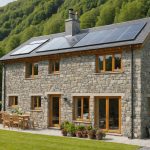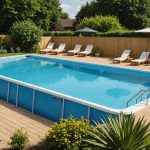EPS insulation offers reliable thermal efficiency that keeps your home comfortable year-round while lowering energy bills. Its durability and moisture resistance ensure lasting performance with minimal upkeep. Compared to other insulation types, EPS stands out for cost-effectiveness and environmental benefits, making it a smart choice for any homeowner seeking long-term comfort and savings. Discover why EPS insulation consistently outperforms alternatives in efficiency, resilience, and sustainability.
Key Benefits of EPS Insulation for Home Comfort
EPS insulation benefits stand out most prominently in its superior thermal efficiency, which ensures consistent indoor temperatures year-round. Thanks to its closed-cell structure, EPS insulation minimizes heat transfer, keeping homes warm during winter and cool during summer. This thermal efficiency directly supports enhanced home comfort by reducing drafts and cold spots.
A lire également : What are the best practices for maintaining a thatched roof in the UK?
When comparing insulation types, EPS insulation holds a strong position. Unlike fiberglass or cellulose, EPS maintains its insulating properties over time without sagging or settling, contributing to sustained thermal efficiency. This durability makes EPS insulation a reliable choice for homeowners seeking long-term comfort.
Another key EPS insulation benefit is its ability to provide proven cost savings. The energy efficiency it offers reduces heating and cooling expenses significantly. Over time, reduced utility bills mean EPS insulation effectively pays for itself, offering a practical financial advantage alongside improved home comfort.
Dans le meme genre : What are the top 5 eco-friendly insulation materials for homes in Wales?
For those weighing their options, understanding the insulation comparison between EPS and alternatives is crucial. EPS delivers consistent performance, high compressive strength, and moisture resistance, which contribute to its effectiveness in various climates and building types. This combination makes EPS an excellent investment for anyone prioritizing both energy savings and a comfortable living environment.
Energy Savings and Cost-Effectiveness of EPS Insulation
EPS insulation energy savings stem primarily from its excellent thermal resistance, which significantly lowers heating and cooling demands in homes. When EPS insulation is installed, homeowners observe a marked reduction in energy consumption because it effectively minimizes heat transfer through walls and roofs. This property directly translates into reduced utility bills, making EPS insulation a cost-effective home insulation choice.
In terms of financial impact, the initial cost of EPS insulation installation is often offset by long-term savings on energy expenses. Real-world homeowner experiences confirm that payback periods for EPS insulation can be remarkably short, sometimes just a few years, especially in climates with extreme temperature fluctuations. This demonstrates that investing in EPS insulation not only enhances comfort but also delivers substantial economic benefits over time.
Moreover, the durability and low maintenance requirements of EPS insulation contribute to its cost-effectiveness. Unlike some insulation materials that degrade or settle, EPS maintains its insulating properties without frequent replacements. These factors combine to make EPS insulation energy savings both immediate and enduring, offering homeowners a wise balance of performance and financial prudence.
For homeowners seeking to optimize energy efficiency while managing costs, considering EPS insulation is a strategic step. The clear link between EPS insulation energy savings, reduced utility bills, and overall cost-effective home insulation underscores why EPS remains a favored solution among energy-conscious consumers.
Durability and Lifecycle Advantages of EPS
EPS insulation stands out as a durable insulation solution due to its remarkable resistance to compression, aging, and pests. These properties contribute directly to its reputation as a long-lasting EPS material, making it a popular choice for both new construction and renovation projects.
One of the key benefits of EPS insulation is its ability to maintain structural integrity over extended periods, unlike many organic insulation materials that may degrade or require frequent replacement. This durability stems from its closed-cell structure, which effectively resists moisture intrusion and pest infestation. As a result, EPS provides consistent thermal performance without significant deterioration, translating to lower lifecycle costs and greater energy savings over time.
Maintenance demands for EPS are minimal, often described as maintenance-free insulation. Unlike fiberglass or natural fiber alternatives, EPS does not settle, crumble, or lose effectiveness through exposure to environmental stressors. This reliability reduces the need for inspections or repairs, offering building owners peace of mind about the ongoing insulation quality.
Numerous case studies demonstrate EPS’s longevity in residential settings. For example, homes insulated with EPS over 30 years ago still show excellent thermal performance today, highlighting the material’s ability to withstand decades of use without loss of function. This proven track record reinforces why EPS insulation remains a trusted option for those seeking both efficiency and durability.
For additional insights into the benefits of EPS insulation and its role in enhancing building performance, exploring resources dedicated to EPS technology can be very informative. This material’s long-lasting EPS characteristics make it a sound investment for any project prioritizing durability and energy efficiency.
Moisture and Mold Resistance of EPS
Moisture-resistant insulation like EPS insulation is engineered to combat water infiltration effectively. Its closed-cell structure acts as a formidable barrier, repelling water and significantly reducing the risk of mold growth. This characteristic makes EPS an excellent choice for areas prone to high humidity or exposure to moisture.
In environments such as basements, crawlspaces, and roofs, where moisture accumulation is common, EPS insulation performs reliably. It supports mold prevention by limiting the damp conditions that mold spores need to thrive. This contributes to healthier indoor environments, ensuring better indoor air quality for occupants.
Using EPS insulation for humid climates not only addresses moisture concerns but also enhances thermal performance. Its ability to maintain dryness within wall cavities and structural components helps protect building materials from deterioration. For these reasons, EPS insulation remains a preferred moisture-resistant insulation solution that actively supports mold prevention in sensitive applications.
For those interested in exploring these benefits further, the advantages of incorporating EPS insulation into various building projects are well documented, ensuring long-term moisture management and structural protection.
Environmental Impact and Sustainability Considerations
When exploring eco-friendly insulation options, EPS insulation stands out due to its remarkable sustainability profile. EPS manufacturing is highly efficient, consuming less energy compared to other insulation materials. This translates into a low environmental footprint during production, making EPS a responsible choice for environmentally conscious builders and homeowners.
One crucial aspect is the impressive EPS recycling potential. EPS insulation can be recycled multiple times without degrading its thermal performance. At the end of its useful life, EPS products are often processed into new insulation or other applications, minimizing landfill waste and reducing resource consumption. This closed-loop recycling capability enhances its sustainability credentials.
Additionally, EPS insulation benefits from a range of environmental certifications and third-party assessments that verify its minimal environmental impact and compliance with green building standards. These certifications provide assurance that EPS aligns with modern sustainability goals, supporting greener construction practices.
Choosing EPS means opting for a material that not only improves energy efficiency but also supports the broader commitment to sustainable building materials. For those seeking more details on its environmental benefits, resources on EPS insulation offer further insight.
Ease of Installation and Versatile Application Options
EPS insulation stands out for its easy to install insulation features, making it a preferred choice among professionals and DIY enthusiasts alike. Due to its lightweight panels, transportation to the site and installation become straightforward tasks, reducing labor time and minimizing physical strain. This simplicity allows for smoother project flow, beneficial especially in tight construction schedules.
Its versatility extends to numerous applications, fitting a wide variety of construction types. EPS can be effectively used in both retrofit projects and new builds, readily adapting to different wall and roof designs. This capability ensures that builders can rely on one solution for multiple insulation needs without compromising performance or compatibility. Professionals often highlight EPS for walls and roofs as an ideal material that offers consistent thermal protection regardless of the setting.
The inherent design of EPS also lowers the risk of installation errors. Unlike insulation materials that require complicated layering or precise alignment, EPS panels provide uniform coverage with fewer gaps. This consistent coverage contributes directly to better energy efficiency and long-term durability of the building envelope. Such reliability is crucial in maintaining the insulation’s effectiveness over time, demonstrating why EPS is favored for both residential and commercial applications.
For those considering improved insulation options, exploring the benefits of EPS insulation provides insight into how versatile and manageable this material is during installation. It effortlessly meets the demands of diverse projects while offering real advantages in ease and effectiveness.











